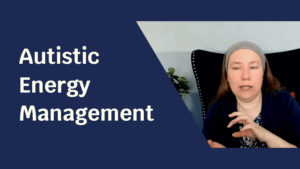This is the second part of an article that started here, describing the two distinct types of non-speaking autism. In this part, I’ll describe six ways you can help.
How to help: play stress detective
So what can you do to help?
There’s a lot you can do.
…when your child has a meltdown, ask “why now?”
Start by trying to figure out what things or situations make your children’s behavior worse. Those are clues to finding their individual sources of stress.
For example, when your child has a meltdown, ask “why now?” Is there a pattern? What’s going on in this situation? What just changed? And what happened earlier in the day?
Sometimes the real problem isn’t the thing that just happened–that’s only the straw that broke the camel’s back–the big thing could have been earlier in the day, or even a day or two ago, or it’s just the last in a long series of little things that got to be too much to cope with.
This detective work can be challenging, and I can help you with it if you would like. It will take some time and a lot of investigation, but if you can reduce even a few of the stressors, it will make everything else much easier.
How to help: assume understanding
Also, assume they understand everything that’s going on around them at an age-appropriate level. If your child is five, and you would expect any other five year old to understand it, assume they do as well.
No one likes being talked about right in front of them, especially when it’s about all of the things they can’t do, or how difficult they’re making your life. That’s just depressing.
And even if they can’t respond, explain what’s going on around them just like you would to anyone else of their age. Don’t use baby talk, use age-appropriate language.
And read them age-appropriate books. Everyone loves good stories. I’ve talked to a few parents whose kids resisted this at first, so they just read aloud near the child, for a few minutes or a few pages. It was a new experience for the kids and that itself was a bit stressful, but after a few weeks, the kids began to engage and wanted more.
How to help: presume competence
Another big thing is to presume competence.
Sadly, a lot of special needs education is built around the presumption that the children cannot do things. Instead, assume that they can.
Assume that they want to try.
Assume that they take pride in their accomplishments, however small they may look to outsiders—you know very well that even small gains are hard won and worth celebrating. So celebrate with your child!
How to help: accept alternative communication
Also, look for alternative methods of communication.
Instead of trying to get them to talk, find other ways to communicate.
Accept pointing and grunting if that’s what they can do. Use a picture board or let them grab your hand and lead you to what they want.
Especially if they are in the first group (granted, you may not be able to tell for sure), find them an RPM teacher.
A teacher is really wonderful to help you get started with this, but the method isn’t really that difficult, and part of what the teacher does is to teach the parents how to continue it on their own. If there’s no one near you, here’s a video to get you started, and some examples of what it’s like in action.
How to help: don’t focus on speaking
Since speaking itself isn’t the issue, focusing on speaking isn’t going to help much.
In fact, it can add a great deal of stress, making speaking even less likely.
Think about it like this. When you’ve lost your keys, and someone suggests, “Well did you look everywhere?” How do you feel? Since that’s probably the first thing you tried, and you didn’t find the keys, and you’re already stressed about the keys and now you’re running late for an appointment, you might feel a tad irritated.
Let’s say you take a deep breath, and patiently explain that you did that, and it didn’t help. It would be reasonable to expect them to come up with a different suggestion. But what if they offered again, “How about you look everywhere?” Again, you explain that you did that, yet they insist, “You know, you really should look everywhere.” Are you angry yet?
When speaking is not something that can be pushed, or prompted, or forced out of someone, insisting on it over and over isn’t going to suddenly make things better.
And an intense focus on speaking—something your child can’t do anything about—is likely to make your child more frustrated, and angry, or withdrawn, and put up barriers to alternatives that might actually make a difference.
How to help: one more thing
There’s one more thing.
Even if you’re convinced that your child does have a genuine intellectual disability—rather, especially if your child does have a genuine intellectual disability—there’s one more thing.
This may take some deep personal reflection, because it is so deeply ingrained in our culture that it is difficult to even notice.
Our Western culture, going way back to the ancient Greeks, has had this implicit assumption built into the basic structure of how we live and teach and work, that being smart is equated with having value.
And even more subtly, that those who are not smart are not as worthy of our time and effort, and patience, consideration, empathy, and compassion—because what’s the point, after all, as they’ll never amount to anything anyway, right?
So sometimes, without really meaning to, we can slip into treating people as a problem to be dealt with, or as a situation to be managed.
This is where we really get to test our values. Do we really believe—and demonstrate—that all people deserve our understanding and care, no matter how much or little we expect they will ever give back, to us or to society?
Those people who are most vulnerable need these values put into action more than anyone. Please, on behalf of those who cannot ask, please treat those with the greatest impairments with the same dignity and respect as every person.
Okay, end of soapbox.
How I can help you
If this is new for you, it can be a lot to take in. I’m happy to talk to you and answer any questions you want, just go to my contact page. No obligation. No sales pitch. Just help.
If you’re ready to take action, there are a few ways I can help you on that path.
The biggest way I can help you is to do the Safe and Sound Protocol with your child. For both groups, this could considerably reduce sensory overstimulation, reducing meltdowns and helping the other work you are doing with them be more effective.
I can also help you become a stress detective, to figure out what’s triggering your child, potential sensory issues, information processing challenges, and can talk you through suggestions and strategies that you can use on a daily basis.
I can do some work with your child directly, but through a remote format (the only option at the moment) I can’t work on RPM with them directly. That really has to be in person. And anyway, I’m not trained in RPM yet, though I do want to take that training soon because my heart is drawn to these individuals.
What I can do remotely with your child is walk them through body awareness (interoceptive) activities, which will lay a groundwork for motor skills, and may help a little with reducing sensory overwhelm.
I may also be able to help with a few other things, depending on your child’s individual needs. We can talk about that together.
In closing
Non-speaking people, autistic and not, have been misunderstood and misrepresented for a very long time. There are social, philosophical, and historical reasons why, which I won’t get into here, but we are beginning to learn so much more about them and now have the opportunity to make their lives so much more inclusive, and to enrich ours by expanding our understanding of human experience.





One Response
Pls send me joy of learning thanks